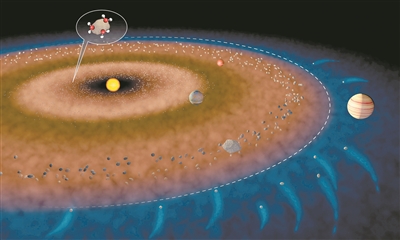
The white dotted line in the figure shows the boundary between the inner solar system and the outer solar system, and the asteroid belt is roughly located between Mars and Jupiter. Bubbles near the top of the image show that water molecules are attached to rock fragments, indicating the type of objects that may bring water to the earth.
Image source: Jack Cook/woods hole oceanographic institution
Beijing Science and Technology Daily, March 16th (Reporter Zhang Jiaxin) Water accounts for 71% of the earth’s surface area, but no one knows how or when such a large amount of water arrived and existed on the earth. A new study published in the journal Nature on 15th brought scientists one step closer to answering this question. The researchers found that the water on the earth did not come from molten meteorites.
The research team of the University of Maryland analyzed the molten meteorites that have been floating in space since the formation of the solar system 4.5 billion years ago. They found that the water content of these meteorites was extremely low. In fact, they are one of the driest substances ever measured. These results make researchers rule out that they are the main source of water on the earth, which is of great significance for finding water and life on other planets.
The researchers analyzed seven molten meteorites, that is, spherulite-free meteorites, which split from at least five "planetesimals" and fell into the earth for billions of years. These planetesimals collided to form planets in the solar system. During the melting process, many of these micrometeoroids were heated by the decay of radioactive elements in the early solar system, causing them to split into layers with crust, mantle and core.
Since these meteorites have only recently landed on the earth, this experiment measured their volatiles for the first time. The researchers used electron probes to measure their magnesium, iron, calcium and silicon levels, and then used secondary ion mass spectrometry to measure their water content.
To reduce pollution, the researchers first baked their samples in a low-temperature vacuum oven to remove any surface water. The sample must be dried again before it can be analyzed in the secondary ion mass spectrometer.
After analyzing the samples of non-chondrite, the researchers found that water accounts for less than two parts per million in its mass. In contrast, the wettest meteorite — — Carbonaceous chondrites contain up to 20% water (by weight), which is 100,000 times that of the meteorite samples studied by the team. This means that no matter where these micro-planets originated in the solar system, and no matter how much water they had in the beginning, the heating and melting of micro-planets will lead to almost all water loss.
The researchers found that contrary to popular belief, not all extrasolar bodies are rich in water. This led them to conclude that water was probably transported to the earth through unmelted meteorites or chondrites.